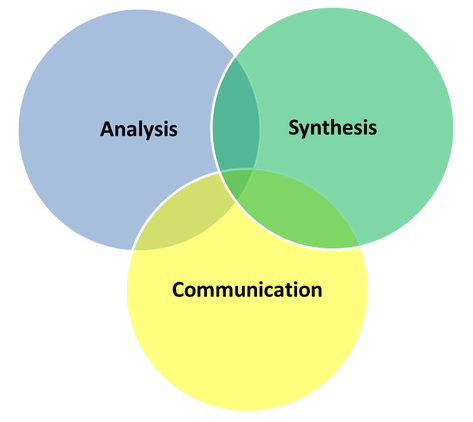Business Analyst: a title that doesn’t reflect the profession
It struck me the other day that business analysis as the name of the profession doesn’t really reflect what’s involved in it.
Analysis is only one part of a business analyst’s activities, and perhaps not even the biggest or the most important. What business analysts do actually consists of three key categories:

Analysis
The definition of analysis I use is that it’s a process of breaking information into smaller parts or transforming information in order to achieve a better understanding. In other words, it means taking a volume of information, processing it and deriving insights or converting it into a new form.
If we relate this to the BABOK, activities from the Requirements Analysis and Enterprise Analysis areas fall under this category.
Synthesis
I consider synthesis to be the opposite of analysis. It involves combining entities to create something new.
Naturally, synthesis in small quantities permeates analysis and communication, as there is always an element of creation in formulating the requirements, understanding business needs, finding an effective way to put the message across and so on.
However, I think it’s useful to separate out the range of activities which can be considered to be predominantly synthesis into a separate category.
A BA has to create a number of plans as part of Business Analysis Planning and Monitoring. A BA also has to synthesise solutions based on the collected requirements, business goals, the existing enterprise structure and so on. These are the areas of the BABOK where synthesis dominates.
Communication
The third category, communication, is often not given its due attention, and this is why I think it’s important to highlight the three categories of BA tasks. Any activity performed by a business analyst has a communication component. Without communication, other activities can’t be performed successfully.
Requirements Elicitation and Requirements Management and Communication are the two areas of the BABOK where communication is predominant.
However, if we dig a little bit deeper, we realise that all other areas also require communication because inevitably other people have to be involved, and no work is done in isolation.
The activities in every BABOK area have their outputs (documents), and outputs are communication (assuming that someone uses them).
For example, the output of Business Analysis Planning and Monitoring is planning documents. Requirements Analysis results in requirements documents. Solution Assessment and Validation produces documents describing solution alternatives. All of these documents will be used by the BA or by other stakeholders.
It becomes clear that a successful BA is not only able to analyse information and synthesise solutions, but is also an expert communicator. For this reason, I’d like to talk about communication in more detail.
Communication and BA success
It’s important to keep in mind that a lack of effective communication doesn’t just affect a BA’s productivity. The effectiveness of communication can mean a difference between a successful or a failed project.
Communication is pivotal in eliciting the right set of requirements. “The right set” encompasses several things. It means that no requirements are missed. It also means that all the collected requirements are relevant to satisfying the business need, i.e. there is only what’s necessary and nothing more. Finally, the correct requirements have to be elicited, which involves collating and filtering input from a lot of different people, and transforming it into a cohesive whole.
This isn’t easy, and the process of elicitation is ripe with opportunities for error. With enough errors, the whole project can go off the rails and become bogged down in too many requirements, go in the wrong direction or not go far enough.
Communication is also crucial in ensuring that the requirements are understood, in maximising stakeholder engagement, and ultimately in making sure that the correct solution which fully addresses the business need is implemented.
Supercharge communication with visuals
Hopefully, you agree that communication is an essential ingredient in the business analysis profession. In addition, the fact that a very large proportion of a BA’s time is spent communicating means that this is the area with the largest potential for productivity gains.
With the constant drive for higher productivity, it’s logical to try to boost performance in this area first and foremost.
As we’ve seen, there are two dimensions for assessing communication. One dimension is the quality of delivering or obtaining information. The other is how long it takes.
At Aotea Studios we believe that communicating visually is the easiest way to achieve large gains in both of these dimensions. In the next blog post, I will examine this idea in more detail.
How about some help with visuals?
Creating great visuals can be difficult. If you’re a BA and you’re wondering how you could apply visuals in your work to become more effective and more productive, check out our Visual Communication Guide for BAs. We get a lot of positive feedback from happy stakeholders thanks to the system described in the guide. Now you can apply it too.

New! We have published a new book: A Navigator to Business Analysis.
Over 400 pages of practical, useful material will help you build your skills and advance your career! Find out more and get free excerpt.
Free course: BABOK 3 Navigation Maps
Subscribe and get an overview of the knowledge areas in BABOK 3. (Very occasionally, we may let you know about discounts and specials).